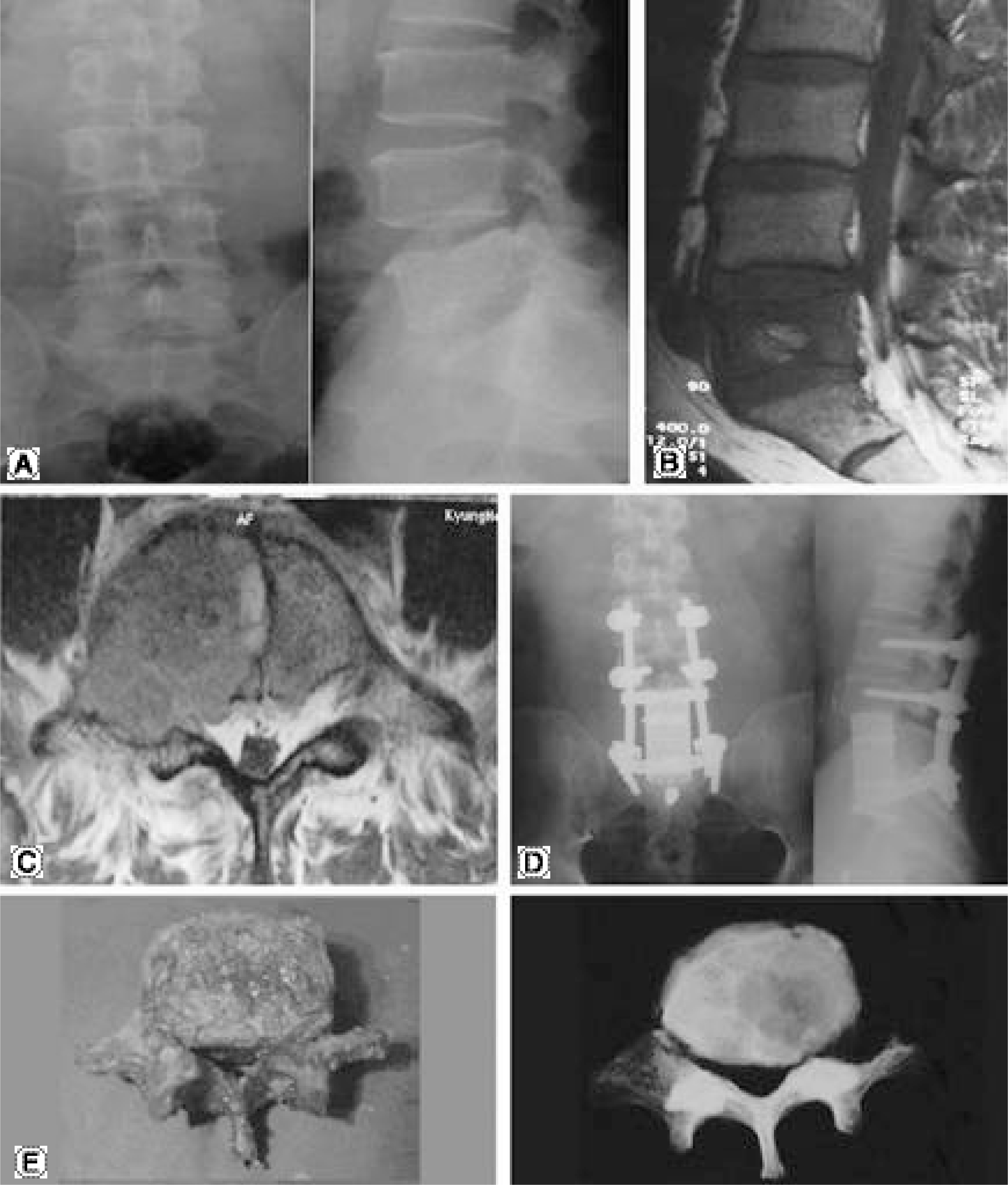J Korean Soc Spine Surg.
2003 Dec;10(4):303-310.
Total en bloc Spondylectomy for Solitary Metastatic Spinal Tumor
- Affiliations
-
- 1Department of Orthopaedic Surgery, School of Medicine, Kyung Hee University, Seoul, Korea. ktkim@khmc.or.kr
- 2Department of Orthopaedic Surgery, School of Medicine, Hallym University, Chuncheon, Korea.
Abstract
- STUDY DESIGN: To analyze the clinical and radiological outcomes retrospectively.
PURPOSE: To evaluate the efficacy of a total en bloc spondylectomy in solitary metastatic spinal tumors.
SUMMERY OF LITERATURE REVIEW: In a conventional operation of a spinal metastatic tumor it is difficult to perform a wide excision, and several reports have suggested a total en bloc spondylectomy for wide or marginal resections.
MATERIALS AND METHODS
Ten patients, with solitary spinal metastasis, were underwent a total en bloc spondylectomy, with a mean follow-up of 15 months. The locations of the tumors were the thoracic spine and lumbar spine in 4 and 6 cases, respectively. The clinical and radiological outcomes were assessed using the McAfee pain scale, Frankel neurologic grading, radiological extent of the lesion and local recurrence. Metastatic spinal tumors were classified by the system of Tomita. A pathological study of the resected vertebra was performed to evaluate the surgical margin.
RESULTS
The preoperative back pain was grades IV, III, II and 0 in 4, 3, 2 and 1 case, respectively. The postoperative back pain was grades III, I and 0 in 3, 1 and 6 cases by the McAfee pain scale, respectively. The neurologic deficit was improved completely in all cases. There were 3 and 7 cases of types 4 and 5 by the Tomita's classification, respectively. The pathological results were wide margin and marginal margin in 4 and 6 cases, respectively. There were no local recurrences at the time of the last follow-up.
CONCLUSION
All patients maintained good clinical and radiological results. A total en bloc spondylectomy was a useful treatment option for solitary metastatic tumors.
MeSH Terms
Figure
Reference
-
1). Roy-Camille R, Mazel CH, Sailant G, Lapresle PH. Treatment of malignant tumors of the spine with posterior instrumentation. (in Sundaresan N, Schmidek HH, Schiller AL, Rosenthal DI(eds), Tumor of the spine. WB saunders. Philadelphia. 473–487. 1990.2). Stener B. Total spondylectomy in chondrosarcoma arising from the seventh thoracic vertebra. J Bone Joint Surg. 1971; 53-B:288–295.
Article3). Sundaresan N, DiGiacinto GV, Krol G, et al. Spondylectomy for malignant tumors of the spine. J Clin Oncol. 1989; 7:1485–1491.
Article4). Abe E, Sato K, Tazawa H, et al. Total spondylectomy for primary tumor of the thoracolumbar spine. Spinal Cord. 2000; 38:146–152.
Article5). Lubicky JP, Patel NS, DeWald RL. Two-stage spondylectomy for giant cell tumor of L4. A case report. Spine. 1983; 8:112–115.6). Tomita K, Kawahara N, Baba H, et al. Total en bloc spondylectomy: A new surgical technique for primary malignant vertebral tumors. Spine. 1997; 22:324–333.7). De Wald RL, Bridwell KH, Prodromas C, Rodts MF. Reconstructive spinal surgery as palliation for metastatic malignancies of the spine. Spine. 1985; 10:21–26.
Article8). Solini A, Paschero B, Orsini G, Guerico N. The surgical treatment of metastatic tumors of the lumbar spine. Ital J Orthop Traumatol. 1985; 11:427–442.9). McAfee PC, Zdeblick TA. Tumors of the thoracic and lumbar spine: Surgical treatment via the anterior approach. J Spinal Disord. 1989; 2:145–154.10). Frankel HL, Hancock DO, Hyslop G, et al. The value of postual reduction in the initial management of closed injuries of the spine with paraplegia and tetraplegia. Paraplegia. 1969; 7:179–192.11). Paul LA. Metastatic disease of the spine. (in Bridwell KH and DeWald RL eds, The Textbook of Spinal Surgery. 2nd ed.Philadelphia: Lippincott-Raven;p. 2027–2033. 1997.12). Kim WJ. Spinal tumors. (in Suk SI: Spinal Surgery. 436–469. 1997.13). Savini R, Gherlinzoni F, Morandi M, et al. Surgic al treatment of giant-cell tumor of the spine. The experience at the Istituto Ortopedico Rizzoli. J Bone Joint Surg. 1983; 65-A:1283–1289.14). Boriani S, Biagini R, De Lure F, et al. En bloc resections of bone tumors of the thoracolumbar spine. A preliminary report. Spine. 1996; 21:1927–1931.15). Van Dijk M, Cuesta MA, Wuisman PIJM. Thorascopi -cally assisted total en bloc spondylectomy: two-case report. Surg Endosc. 2000; 14:849–852.16). Chung JY. Spinal tumors. J Kor Spine Surg. 1999; 6:316–325.17). Tomita K, Kawahara N, Kobayashi T, et al. Surgi cal Strategy for Spinal Metastases. Spine. 2001; 26:298–306.18). Kostuik JP, Errico TJ, Gleason TF, et al. Spinal stabilization of vertebral column tumors. Spine. 1988; 13:250–256.
Article19). Harrington KD. Anterior cord decompression and spinal stabilization for patients with metastatic lesions of the spine. J Neurosurg. 1984; 61:107–117.
Article20). Hosono N, Yonenobu K, Fuji T, Ebara S, Tamoshita K, Ono K. Orthopedic management of spinal metastasis. Clin Orthop. 1995; 312:148–159.21). Eric M, Laurence DR, Jeffrey SW, Ziya LG. Total en bloc lumbar spondylectomy. J Neurosurg. 2001; 95:264–269.
- Full Text Links
- Actions
-
Cited
- CITED
-
- Close
- Share
- Similar articles
-
- Total Body Replacement with an Expandable Cage after en Bloc Lumbar Spondylectomy
- Combined en Bloc Spondylectomy and Chest Wall Resection for Malignant Tumors Invading Spinal Column and Chest Wall
- Acute and Delayed Epidural Hematoma After Total Spondylectomy for a Metastatic Spinal Tumor: A Case Report
- Total En Bloc Lumbar Spondylectomy of Follicular Thyroid Carcinoma
- Thoracoscopic Anterior Release of the Spine in Total en Bloc Spondylectomy for Primary Thoracic Spinal Tumor : A case report



